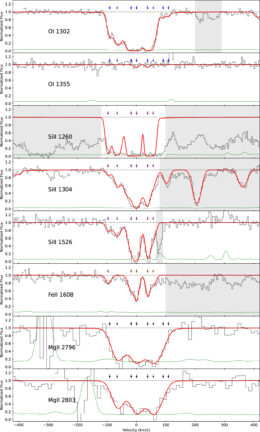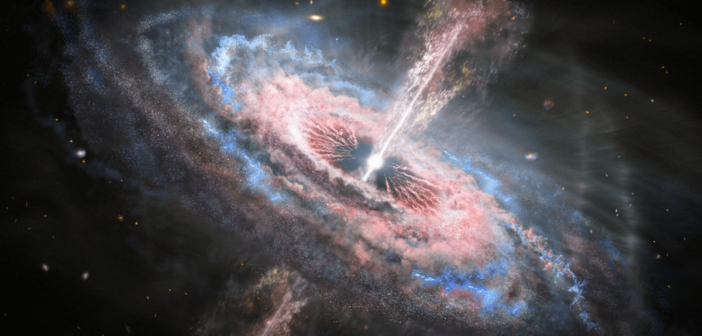Astronomers have long known that the universe has grown more metallic over time: in its younger, purer days, it was composed almost entirely of hydrogen and helium. Recently, however, researchers discovered a galaxy that was notably ahead of the trend and had already amassed a high metal content only a billion years after the Big Bang.
Building Starstuff
Nearly all of the atoms heavier than helium began their lives in a star, the forges of the cosmos responsible for crushing primordial materials into the rich array of elements we see today. These forges run day and night, constantly churning through the universe’s finite supply of hydrogen and helium. Consequently, the overall budget of hydrogen goes down over time, while the proportion of heavier elements (which astronomers call “metals,” regardless of their actual metallic properties) grows. When astronomers look back in time and observe the high-redshift universe, they expect to find mostly pure hydrogen and helium, unpolluted by the starstuff that makes up rocks and people and telescopes.
This prediction usually stands up to observations, and when looking at galaxies with redshifts beyond z = 4 (those born in the first roughly 1.5 billion years after the Big Bang), researchers most often observe clouds of gas with barely any metals. However, a collaboration led by Jianghao Huyan, University of South Carolina, recently discovered a surprising contradiction to this harmonious agreement: their observations of hazy galaxy at z = 4.7 revealed a metal fraction more than two orders of magnitude above the prediction for such a young source.
Mystery Metals

Zoomed-in regions of the measured spectrum centered on different metal absorption lines. The red curve represents the best-fitting model spectrum, while the black histogram is shows their data. [Huyan et al. 2023]
They found that the galaxy possessed a substantial amount of carbon, oxygen, magnesium, and other heavy elements. In fact, just 1.2 billion years after the Big Bang, this galaxy already had a higher relative amount of carbon and oxygen than our own Sun that was born many billions of years later. This was a startling find: models of early galaxy formation expect a significantly smaller fraction of metals, even when accounting for the large uncertainties about the behavior of theorized-but-not-yet-seen first-generation stars.

Previous measurements and predictions of galaxy metallicity as a function of redshift. The galaxy in question here is marked as the pink triangle that lies far above the model curve. Click to enlarge. [Huyan et al. 2023]
Citation
“Discovery of Super-enriched Gas ∼1 Gyr after the Big Bang,” Jianghao Huyan et al 2023 ApJL 954 L19. doi:10.3847/2041-8213/aceefe

